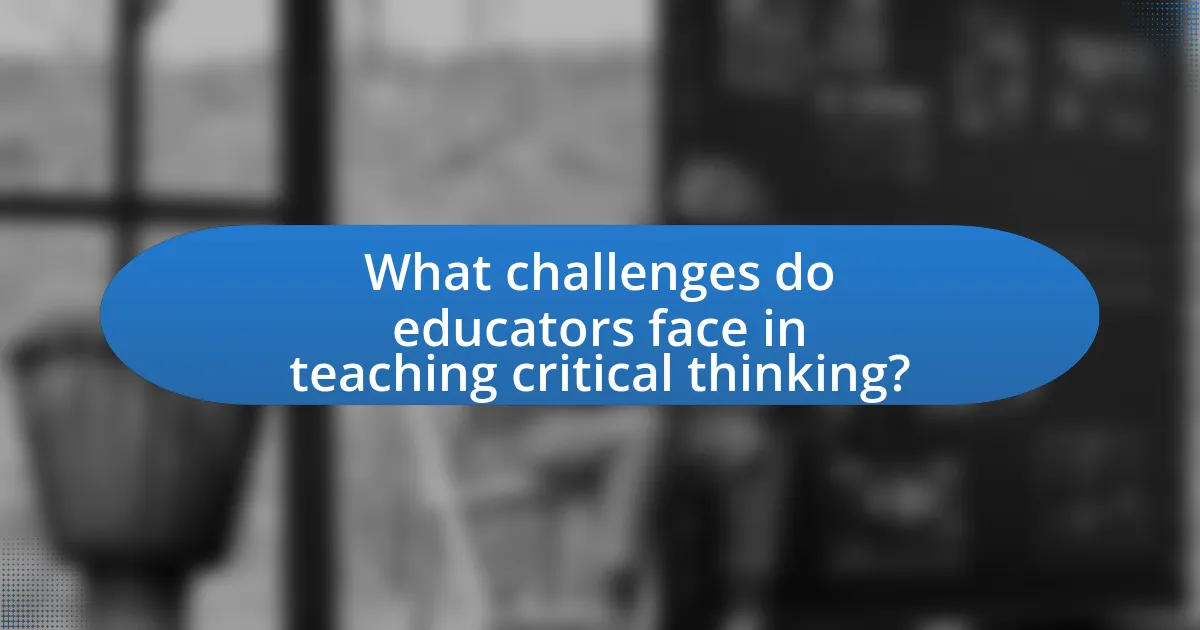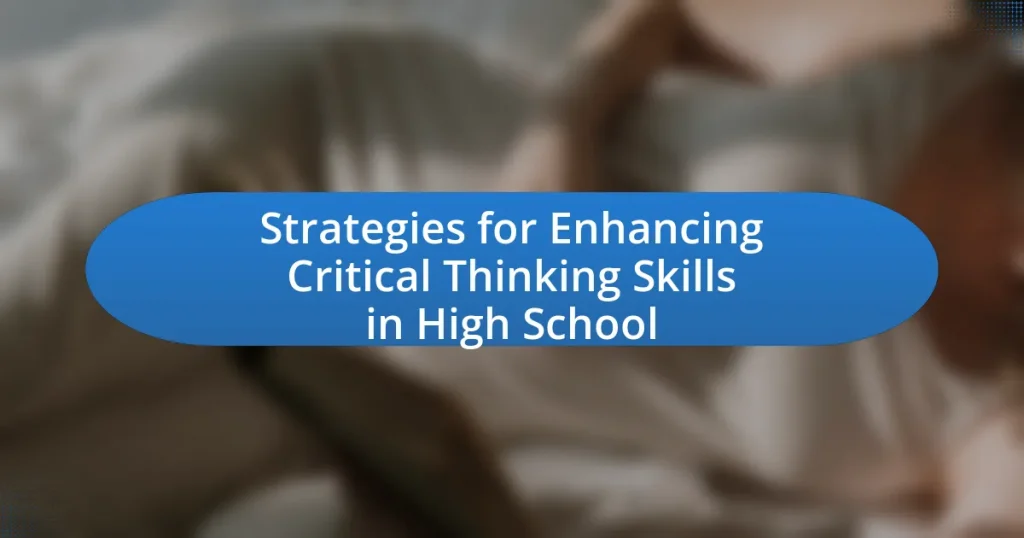The article focuses on strategies for enhancing critical thinking skills in high school students. It outlines key approaches such as inquiry-based learning, classroom discussions, collaborative learning, and specific teaching methods like Socratic questioning and problem-based learning. The article emphasizes the importance of creating a supportive classroom environment that values diverse perspectives and encourages open dialogue. Additionally, it discusses the long-term benefits of critical thinking, its impact on academic performance and career readiness, and the challenges educators face in teaching these skills effectively.

What are the key strategies for enhancing critical thinking skills in high school?
Key strategies for enhancing critical thinking skills in high school include encouraging inquiry-based learning, fostering discussions and debates, integrating problem-solving activities, and promoting reflective practices. Inquiry-based learning allows students to ask questions and explore topics deeply, which enhances their analytical skills. Discussions and debates encourage students to articulate their thoughts and consider multiple perspectives, thereby improving their reasoning abilities. Problem-solving activities, such as real-world scenarios, challenge students to apply their knowledge creatively and critically. Reflective practices, such as journaling or peer feedback, help students evaluate their thought processes and decisions, leading to greater self-awareness and improved critical thinking. These strategies are supported by educational research indicating that active engagement in learning significantly boosts critical thinking skills among high school students.
How can educators foster an environment that promotes critical thinking?
Educators can foster an environment that promotes critical thinking by implementing inquiry-based learning strategies. Inquiry-based learning encourages students to ask questions, investigate, and explore topics deeply, which enhances their analytical skills. Research by the National Research Council indicates that such approaches lead to improved problem-solving abilities and greater engagement in learning. Additionally, creating a classroom culture that values diverse perspectives and encourages open dialogue allows students to challenge assumptions and develop their reasoning skills. This combination of inquiry-based learning and a supportive classroom environment effectively cultivates critical thinking among high school students.
What role does classroom discussion play in developing critical thinking?
Classroom discussion plays a crucial role in developing critical thinking by fostering an environment where students engage in dialogue, analyze diverse perspectives, and articulate their reasoning. This interactive process encourages students to question assumptions, evaluate evidence, and construct well-reasoned arguments. Research indicates that students who participate in structured discussions demonstrate improved critical thinking skills, as they learn to navigate complex ideas and collaborate with peers. For instance, a study published in the Journal of Educational Psychology found that students involved in discussion-based learning scored significantly higher on critical thinking assessments compared to those who engaged in traditional lecture formats. This evidence underscores the effectiveness of classroom discussions in enhancing critical thinking abilities among high school students.
How can collaborative learning enhance critical thinking skills?
Collaborative learning enhances critical thinking skills by fostering an environment where students engage in dialogue, debate, and problem-solving with peers. This interaction encourages students to articulate their thoughts, consider alternative perspectives, and evaluate the validity of different arguments. Research by Johnson and Johnson (1994) indicates that cooperative learning strategies lead to higher achievement and greater critical thinking abilities compared to individual learning. Furthermore, collaborative learning promotes active participation, which has been shown to deepen understanding and retention of complex concepts, thereby enhancing critical thinking.
What specific teaching methods can be employed to improve critical thinking?
Specific teaching methods that can be employed to improve critical thinking include Socratic questioning, problem-based learning, and collaborative learning. Socratic questioning encourages students to think deeply by challenging assumptions and exploring different perspectives, fostering analytical skills. Problem-based learning engages students in real-world problems, requiring them to research, analyze, and propose solutions, which enhances their ability to think critically. Collaborative learning promotes discussion and debate among peers, allowing students to articulate their thoughts and consider alternative viewpoints, thereby refining their critical thinking abilities. Research indicates that these methods significantly enhance students’ critical thinking skills, as evidenced by studies showing improved performance in analytical tasks among students who engage in these practices.
How does problem-based learning contribute to critical thinking development?
Problem-based learning (PBL) enhances critical thinking development by engaging students in real-world problems that require analysis, evaluation, and synthesis of information. This active learning approach encourages learners to identify problems, research solutions, and collaborate with peers, fostering deeper understanding and application of knowledge. Research indicates that PBL improves students’ ability to think critically, as evidenced by a study published in the Journal of Educational Psychology, which found that students participating in PBL scored significantly higher on critical thinking assessments compared to those in traditional learning environments.
What is the impact of Socratic questioning on student engagement and thought processes?
Socratic questioning significantly enhances student engagement and thought processes by promoting critical thinking and deeper understanding. This method encourages students to explore complex ideas through dialogue, fostering an environment where they actively participate in their learning. Research indicates that when students engage in Socratic questioning, they develop higher-order thinking skills, such as analysis, evaluation, and synthesis, which are essential for academic success. A study by Paul and Elder (2006) highlights that Socratic questioning leads to increased student motivation and a greater willingness to engage with challenging material, ultimately resulting in improved academic performance.

Why is critical thinking essential for high school students?
Critical thinking is essential for high school students because it equips them with the ability to analyze information, make informed decisions, and solve complex problems. This skill is crucial in an era where students are bombarded with vast amounts of information from various sources, requiring them to discern credible data from misinformation. Research indicates that students who engage in critical thinking are better prepared for higher education and the workforce, as they can evaluate arguments, identify biases, and develop reasoned conclusions. For instance, a study published in the Journal of Educational Psychology found that students who participated in critical thinking exercises showed significant improvements in their academic performance and problem-solving abilities.
What are the long-term benefits of critical thinking skills?
The long-term benefits of critical thinking skills include improved problem-solving abilities, enhanced decision-making, and increased adaptability in various life situations. Individuals who develop critical thinking skills are better equipped to analyze complex issues, evaluate evidence, and make informed choices, which leads to greater success in both personal and professional contexts. Research indicates that critical thinking is linked to higher academic performance and better job prospects, as employers increasingly value these skills in the workforce. For instance, a study by the Association of American Colleges and Universities found that 93% of employers prioritize critical thinking and communication skills in hiring decisions.
How does critical thinking influence academic performance?
Critical thinking significantly enhances academic performance by enabling students to analyze information, evaluate arguments, and solve problems effectively. This cognitive skill allows learners to approach complex subjects with a structured mindset, leading to improved comprehension and retention of material. Research indicates that students who engage in critical thinking demonstrate higher grades and better test scores, as evidenced by a study published in the Journal of Educational Psychology, which found that critical thinking skills correlate positively with academic achievement across various subjects.
In what ways does critical thinking prepare students for future careers?
Critical thinking prepares students for future careers by enhancing their problem-solving abilities, decision-making skills, and adaptability in dynamic work environments. These skills are essential as employers increasingly seek individuals who can analyze complex situations, evaluate evidence, and make informed choices. Research indicates that 93% of employers prioritize critical thinking in hiring decisions, highlighting its importance in the workplace. Furthermore, critical thinking fosters creativity and innovation, enabling students to approach challenges with unique solutions, which is vital in competitive job markets.
How does critical thinking relate to other skills and competencies?
Critical thinking is intrinsically linked to various skills and competencies, such as problem-solving, decision-making, and effective communication. These skills often rely on the ability to analyze information, evaluate evidence, and synthesize diverse viewpoints, which are core components of critical thinking. For instance, research by Facione (2011) highlights that critical thinking enhances problem-solving abilities by enabling individuals to assess situations more thoroughly and consider multiple solutions. Additionally, effective communication is improved through critical thinking, as it fosters clarity in expressing ideas and reasoning, which is essential in collaborative environments. Thus, critical thinking serves as a foundational skill that enhances and interconnects with other competencies necessary for academic and professional success.
What is the connection between critical thinking and problem-solving abilities?
Critical thinking and problem-solving abilities are closely interconnected, as critical thinking provides the framework for analyzing and evaluating information necessary for effective problem-solving. Critical thinking involves the ability to assess situations, identify biases, and consider multiple perspectives, which are essential skills when approaching complex problems. Research indicates that individuals who engage in critical thinking are better equipped to devise innovative solutions and make informed decisions, as they can systematically break down problems into manageable parts and evaluate potential outcomes. This connection is supported by studies showing that educational programs emphasizing critical thinking lead to improved problem-solving skills among students, highlighting the importance of fostering these abilities in high school curricula.
How does critical thinking enhance communication skills?
Critical thinking enhances communication skills by enabling individuals to analyze information critically, articulate their thoughts clearly, and engage in meaningful dialogue. When students practice critical thinking, they learn to evaluate arguments, identify biases, and construct coherent responses, which directly improves their ability to express ideas effectively. Research indicates that students who engage in critical thinking exercises demonstrate better verbal communication skills, as they can organize their thoughts logically and present them persuasively. For instance, a study published in the Journal of Educational Psychology found that students who participated in critical thinking activities showed a 20% improvement in their ability to communicate complex ideas compared to those who did not. This evidence underscores the significant link between critical thinking and enhanced communication abilities.

What challenges do educators face in teaching critical thinking?
Educators face several challenges in teaching critical thinking, primarily due to a lack of standardized curriculum and assessment methods. Many educational systems do not prioritize critical thinking in their frameworks, leading to insufficient training for teachers on how to effectively integrate these skills into their lessons. Additionally, students often come from backgrounds that emphasize rote memorization over analytical skills, making it difficult for educators to shift their mindset towards critical thinking. Research indicates that only 20% of high school students demonstrate proficiency in critical thinking, highlighting the gap in effective teaching strategies. Furthermore, the pressure of standardized testing can limit the time educators can dedicate to fostering critical thinking, as they may focus more on test preparation than on developing students’ analytical abilities.
How can resistance to critical thinking be addressed in the classroom?
Resistance to critical thinking in the classroom can be addressed by fostering a supportive environment that encourages open dialogue and questioning. Educators can implement strategies such as Socratic questioning, which promotes deeper understanding through guided inquiry, and collaborative learning, where students engage in group discussions that challenge their perspectives. Research indicates that classrooms that prioritize a growth mindset, as outlined by Carol Dweck, enhance students’ willingness to embrace challenges, including critical thinking tasks. Additionally, providing explicit instruction on critical thinking skills, along with real-world applications, can help students see the relevance and importance of these skills, thereby reducing resistance.
What strategies can be used to overcome student reluctance to engage in critical thinking?
To overcome student reluctance to engage in critical thinking, educators can implement strategies such as fostering a supportive classroom environment, integrating real-world problems, and utilizing collaborative learning techniques. A supportive environment encourages students to express their thoughts without fear of judgment, which is essential for critical thinking development. Real-world problems make learning relevant and stimulate students’ interest, as they can see the practical application of their skills. Collaborative learning techniques, such as group discussions and peer reviews, promote engagement and allow students to learn from each other, enhancing their critical thinking abilities. Research by the American Educational Research Association indicates that these strategies significantly improve students’ critical thinking skills and their willingness to participate in discussions.
How can educators assess critical thinking skills effectively?
Educators can assess critical thinking skills effectively by utilizing performance-based assessments that require students to analyze, evaluate, and create solutions to complex problems. These assessments can include case studies, debates, and project-based learning tasks that simulate real-world scenarios. Research indicates that performance assessments provide a more accurate measure of critical thinking abilities compared to traditional testing methods, as they engage students in higher-order thinking processes. For instance, a study published in the “Journal of Educational Psychology” by Paul and Elder (2014) found that students who participated in performance-based assessments demonstrated significantly improved critical thinking skills compared to those who relied solely on multiple-choice tests.
What resources are available to support the teaching of critical thinking?
Resources available to support the teaching of critical thinking include educational frameworks, instructional materials, and online platforms. The Foundation for Critical Thinking offers resources such as books, articles, and workshops designed to enhance critical thinking skills in educational settings. Additionally, the Critical Thinking Community provides a wealth of information, including lesson plans and assessment tools that educators can utilize. Research indicates that integrating these resources into the curriculum can significantly improve students’ analytical and evaluative skills, as evidenced by studies showing enhanced performance in critical thinking assessments when such resources are employed.
What types of materials can enhance critical thinking instruction?
Materials that can enhance critical thinking instruction include case studies, simulations, debates, and problem-based learning activities. Case studies provide real-world scenarios that require analysis and decision-making, fostering deeper understanding. Simulations allow students to engage in experiential learning, where they can apply critical thinking in dynamic environments. Debates encourage students to articulate and defend their viewpoints, promoting analytical skills and perspective-taking. Problem-based learning activities challenge students to solve complex issues, enhancing their ability to think critically and collaboratively. Research indicates that these materials significantly improve students’ critical thinking abilities, as evidenced by studies showing increased engagement and higher-order thinking skills in classrooms that utilize such resources.
How can technology be leveraged to promote critical thinking skills?
Technology can be leveraged to promote critical thinking skills by utilizing interactive tools and platforms that encourage analysis, evaluation, and synthesis of information. For instance, online discussion forums and collaborative platforms like Google Docs enable students to engage in peer review and constructive feedback, fostering deeper understanding and critical evaluation of diverse perspectives. Research by the National Education Association indicates that technology-enhanced learning environments can improve students’ problem-solving abilities and critical thinking skills by providing access to a wealth of information and resources, allowing for inquiry-based learning. Additionally, simulations and educational games can present complex scenarios that require students to apply critical thinking to navigate challenges, thereby enhancing their analytical skills in real-world contexts.
What practical tips can educators implement to enhance critical thinking skills?
Educators can enhance critical thinking skills by incorporating inquiry-based learning into their curriculum. This approach encourages students to ask questions, investigate problems, and develop solutions through research and discussion. Research shows that inquiry-based learning can improve students’ analytical skills and foster a deeper understanding of content (Hattie, 2009). Additionally, educators should implement collaborative group work, which promotes dialogue and diverse perspectives, further enhancing critical thinking. Studies indicate that students engaged in collaborative learning demonstrate higher levels of critical thinking compared to those who work independently (Johnson & Johnson, 2009). Lastly, integrating real-world problems into lessons allows students to apply their critical thinking skills in practical contexts, making learning more relevant and engaging.


